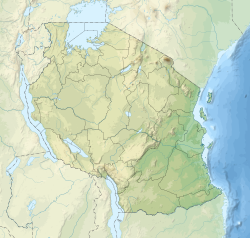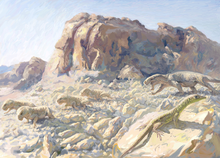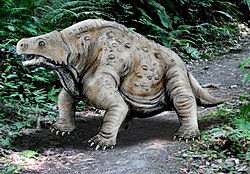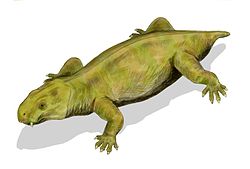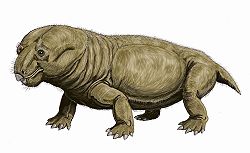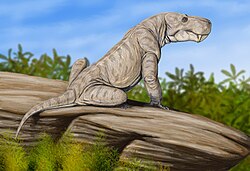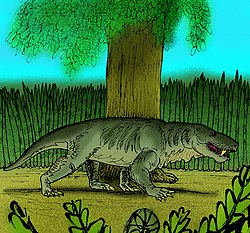| Revision as of 03:46, 16 August 2023 editA bit iffy (talk | contribs)Autopatrolled, Extended confirmed users, Pending changes reviewers, Rollbackers48,426 edits + short description← Previous edit |
Latest revision as of 10:29, 20 November 2024 edit undoBruce1ee (talk | contribs)Autopatrolled, Extended confirmed users, Pending changes reviewers, Rollbackers268,601 editsm fixed lint errors – missing end tag |
| (29 intermediate revisions by 8 users not shown) |
| Line 23: |
Line 23: |
|
| extent = ] |
|
| extent = ] |
|
| area = |
|
| area = |
|
| map = |
|
| map = {{Location map+ | Tanzania |
|
| map_caption = |
|
| map_caption = |
|
|
| relief = 1 |
|
|
| width = 250 |
|
|
| float = center |
|
|
| places = |
|
|
{{ Location map~ | Tanzania |
|
|
| lat_deg = -10.3 |
|
|
| lon_deg = 35.1 |
|
|
| mark = Red pog.svg |
|
|
| marksize = 12 |
|
|
}} |
|
|
}} |
|
}} |
|
}} |
|
|
|
|
|
The '''Usili Formation''' is a ] ] in ]. It preserves fossils of many terrestrial vertebrates from the Permian, including ]s, ]s, ]s and the ] '']''.<ref name=Sidor&el13>{{cite journal | doi = 10.1073/pnas.1302323110 | title = Provincialization of terrestrial faunas following the end-Permian mass extinction | year = 2013 | last1 = Sidor | first1 = C. A. | last2 = Vilhena | first2 = D. A. | last3 = Angielczyk | first3 = K. D. | last4 = Huttenlocker | first4 = A. K. | last5 = Nesbitt | first5 = S. J. | last6 = Peecook | first6 = B. R. | last7 = Steyer | first7 = J. S. | last8 = Smith | first8 = R. M. H. | last9 = Tsuji | first9 = L. A. | journal = Proceedings of the National Academy of Sciences | volume = 110 | issue = 20 | pages = 8129–33 | pmid=23630295 | pmc=3657826 |
|
The '''Usili Formation''' is a ] ] in ]. It preserves fossils of many terrestrial vertebrates from the Permian, including ]s, ]s, ]s and the ] '']''.<ref name=Sidor&el13>{{cite journal | doi = 10.1073/pnas.1302323110 | title = Provincialization of terrestrial faunas following the end-Permian mass extinction | year = 2013 | last1 = Sidor | first1 = C. A. | last2 = Vilhena | first2 = D. A. | last3 = Angielczyk | first3 = K. D. | last4 = Huttenlocker | first4 = A. K. | last5 = Nesbitt | first5 = S. J. | last6 = Peecook | first6 = B. R. | last7 = Steyer | first7 = J. S. | last8 = Smith | first8 = R. M. H. | last9 = Tsuji | first9 = L. A. | journal = Proceedings of the National Academy of Sciences | volume = 110 | issue = 20 | pages = 8129–33 | pmid=23630295 | pmc=3657826 |
|
| doi-access = free }}</ref><ref name=Aenigmastropheus>{{Cite journal | doi = 10.1371/journal.pone.0089165| title = The Origin and Early Evolution of Sauria: Reassessing the Permian Saurian Fossil Record and the Timing of the Crocodile-Lizard Divergence| journal = PLOS ONE| volume = 9| issue = 2| pages = e89165| year = 2014| last1 = Ezcurra | first1 = M. N. D. | last2 = Scheyer | first2 = T. M. | last3 = Butler | first3 = R. J. | pmid=24586565 | pmc=3937355| doi-access = free}}</ref> |
|
| doi-access = free | bibcode = 2013PNAS..110.8129S }}</ref><ref name=Aenigmastropheus>{{Cite journal | doi = 10.1371/journal.pone.0089165| title = The Origin and Early Evolution of Sauria: Reassessing the Permian Saurian Fossil Record and the Timing of the Crocodile-Lizard Divergence| journal = PLOS ONE| volume = 9| issue = 2| pages = e89165| year = 2014| last1 = Ezcurra | first1 = M. N. D. | last2 = Scheyer | first2 = T. M. | last3 = Butler | first3 = R. J. | pmid=24586565 | pmc=3937355| doi-access = free| bibcode = 2014PLoSO...989165E}}</ref> |
|
|
|
|
|
== History of study == |
|
== History of study == |
| Line 34: |
Line 45: |
|
One of the first to study rocks of the Usili Formation was British geologist G. M. Stockley. In 1932, Stockley explored the geology of the Ruhuhu Basin in Tanzania. He called a series of layers dating from the ] to the ] of the Songea Series and divided it into eight units labelled K1-K8. Stockley was also the first to describe fossils from these rocks, naming an older layer the "Lower Bone Bed" and a younger layer the "Upper Bone Bed".<ref name=BBAG09/> |
|
One of the first to study rocks of the Usili Formation was British geologist G. M. Stockley. In 1932, Stockley explored the geology of the Ruhuhu Basin in Tanzania. He called a series of layers dating from the ] to the ] of the Songea Series and divided it into eight units labelled K1-K8. Stockley was also the first to describe fossils from these rocks, naming an older layer the "Lower Bone Bed" and a younger layer the "Upper Bone Bed".<ref name=BBAG09/> |
|
|
|
|
|
In 1957, paleontologist ] described many more fossils from the upper bone beds in his Ph.D. thesis for the ].<ref name=CAJ57>Charig, A. J. (1957). New Triassic archosaurs from Tanganyika, including ''Mandasuchus'' and ''Teleocrater'': Dissertation Abstracts. Cambridge University.</ref><ref name=NB12>{{Cite journal | last1 = Nesbitt | first1 = S. J. | last2 = Butler | first2 = R. J. | doi = 10.1017/S0016756812000362 | title = Redescription of the archosaur Parringtonia gracilis from the Middle Triassic Manda beds of Tanzania, and the antiquity of Erpetosuchidae | journal = Geological Magazine | pages = 225–238 | year = 2012 | volume=150| issue = 2 | s2cid = 232175772 | url = https://semanticscholar.org/paper/7dfcd25c6aaa4e4d9a0a4a6bf024f5a43fe024c6 }}</ref> Subsequently, Stockley's units were renamed, Charig (1963) calling unit K6 the Kawinga Formation, K7 the Kingori Sandstones, and K8 the Manda Formation. Fossils were identified in many ], invalidating Stockley's division into two distinct bone beds. Since Charig's description, the Kawinga Formation has been renamed the Usili Formation, the Kingori Sandstones have become the Kingori Sandstone Member of the ], and Charig's original Manda Formation has become a subunit of the formation called the Lifua Member.<ref name=BBAG09>{{Cite journal | last1 = Butler | first1 = R. J. | last2 = Barrett | first2 = P. M. | last3 = Abel | first3 = R. L. | last4 = Gower | first4 = D. J. | title = A possible ctenosauriscid archosaur from the Middle Triassic Manda Beds of Tanzania | doi = 10.1671/039.029.0404 | journal = Journal of Vertebrate Paleontology | volume = 29 | issue = 4 | pages = 1022–1031 | year = 2009 | s2cid = 86267617 }}</ref> Six formations and one informal unit are currently recognized in the Songea Group (Ruhuhu basin) rocks range in age from ] to ], including the ] (K1), ] (K2), ] (K3), ] (K4), ] (K5), and Usili (K6) formations and the informal ], which include the ] (K7) and ] (K8).<ref name=Sidor&el10>{{Cite journal | doi = 10.1080/02724631003758086| title = Tetrapod fauna of the lowermost Usili Formation (Songea Group, Ruhuhu Basin) of southern Tanzania, with a new burnetiid record| journal = Journal of Vertebrate Paleontology| volume = 30| issue = 3| pages = 696–703| year = 2010| last1 = Sidor | first1 = C. A. | last2 = Angielczyk | first2 = K. D. | last3 = Weide † | first3 = D. M. | last4 = Smith | first4 = R. M. H. | last5 = Nesbitt | first5 = S. J. | last6 = Tsuji | first6 = L. A. | s2cid = 55397720| url = http://digitalcommons.unl.edu/cgi/viewcontent.cgi?article=1379&context=geosciencefacpub}}</ref> |
|
In 1957, paleontologist ] described many more fossils from the upper bone beds in his Ph.D. thesis for the ].<ref name=CAJ57>Charig, A. J. (1957). New Triassic archosaurs from Tanganyika, including ''Mandasuchus'' and ''Teleocrater'': Dissertation Abstracts. Cambridge University.</ref><ref name=NB12>{{Cite journal | last1 = Nesbitt | first1 = S. J. | last2 = Butler | first2 = R. J. | doi = 10.1017/S0016756812000362 | title = Redescription of the archosaur Parringtonia gracilis from the Middle Triassic Manda beds of Tanzania, and the antiquity of Erpetosuchidae | journal = Geological Magazine | pages = 225–238 | year = 2012 | volume=150| issue = 2 | s2cid = 232175772 }}</ref> Subsequently, Stockley's units were renamed, Charig (1963) calling unit K6 the Kawinga Formation, K7 the Kingori Sandstones, and K8 the Manda Formation. Fossils were identified in many ], invalidating Stockley's division into two distinct bone beds. Since Charig's description, the Kawinga Formation has been renamed the Usili Formation, the Kingori Sandstones have become the Kingori Sandstone Member of the ], and Charig's original Manda Formation has become a subunit of the formation called the Lifua Member.<ref name=BBAG09>{{Cite journal | last1 = Butler | first1 = R. J. | last2 = Barrett | first2 = P. M. | last3 = Abel | first3 = R. L. | last4 = Gower | first4 = D. J. | title = A possible ctenosauriscid archosaur from the Middle Triassic Manda Beds of Tanzania | doi = 10.1671/039.029.0404 | journal = Journal of Vertebrate Paleontology | volume = 29 | issue = 4 | pages = 1022–1031 | year = 2009 | bibcode = 2009JVPal..29.1022B | s2cid = 86267617 }}</ref> Six formations and one informal unit are currently recognized in the Songea Group (Ruhuhu basin) rocks range in age from ] to ], including the ] (K1), ] (K2), ] (K3), ] (K4), ] (K5), and Usili (K6) formations and the informal ], which include the ] (K7) and ] (K8).<ref name=Sidor&el10>{{Cite journal | doi = 10.1080/02724631003758086| title = Tetrapod fauna of the lowermost Usili Formation (Songea Group, Ruhuhu Basin) of southern Tanzania, with a new burnetiid record| journal = Journal of Vertebrate Paleontology| volume = 30| issue = 3| pages = 696–703| year = 2010| last1 = Sidor | first1 = C. A. | last2 = Angielczyk | first2 = K. D. | last3 = Weide † | first3 = D. M. | last4 = Smith | first4 = R. M. H. | last5 = Nesbitt | first5 = S. J. | last6 = Tsuji | first6 = L. A. | bibcode = 2010JVPal..30..696S| s2cid = 55397720| url = http://digitalcommons.unl.edu/cgi/viewcontent.cgi?article=1379&context=geosciencefacpub}}</ref> |
|
|
|
|
|
Recent studies have described the Usili Formation as a {{convert|260|m|ft}} thick ]-] succession made up of a lowermost conglomeratic interval that is approximately 5 meters thick, grading up into a trough cross-bedded, coarse-grained, sandstone-dominated interval that is {{convert|25|to|40|m|ft}} thick, overlain by massive nodular siltstone and laminated mudstone beds with minor ribbon sandstones forming the bulk of the succession. Since Parrington (1956), the Usili Formation became widely recognized as a Late Permian formation that correlates with the ] and ] formations of ], as well as with the ]n ] (]). Comparison of Usili tetrapods with those of the lower ] has suggested a broad ] correlation with the '']'', '']'', and '']'' assemblage zones. Sidor ''et al.'' (2010) recognized only one undivided tetrapod faunal assemblage in the Usili Formation, which includes '']'', ]s, ]s, ]ns, ]ns, ]s, and ]s, whose remains were collected from various localities. This suggests that several therapsid genera have unequal stratigraphic ranges and temporal durations in the Ruhuhu and Karoo basins.<ref name=Aenigmastropheus/><ref name=Sidor&el10/> |
|
Recent studies have described the Usili Formation as a {{convert|260|m|ft}} thick ]-] succession made up of a lowermost conglomeratic interval that is approximately 5 meters thick, grading up into a trough cross-bedded, coarse-grained, sandstone-dominated interval that is {{convert|25|to|40|m|ft}} thick, overlain by massive nodular siltstone and laminated mudstone beds with minor ribbon sandstones forming the bulk of the succession. Since Parrington (1956), the Usili Formation became widely recognized as a Late Permian formation that correlates with the ] and ] formations of ], as well as with the ]n ] (]). Comparison of Usili tetrapods with those of the lower ] has suggested a broad ] correlation with the '']'', '']'', and '']'' assemblage zones. Sidor ''et al.'' (2010) recognized only one undivided tetrapod faunal assemblage in the Usili Formation, which includes '']'', ]s, ]s, ]ns, ]ns, ]s, and ]s, whose remains were collected from various localities. This suggests that several therapsid genera have unequal stratigraphic ranges and temporal durations in the Ruhuhu and Karoo basins.<ref name=Aenigmastropheus/><ref name=Sidor&el10/> |
| Line 48: |
Line 59: |
|
{| class="wikitable sortable" |
|
{| class="wikitable sortable" |
|
|- |
|
|- |
|
! Taxon !! Locality !! class="unsortable" | Material !! class="unsortable" | Notes !! class="unsortable" | Images |
|
! Taxon !! Species !! Locality !! class="unsortable" | Material !! class="unsortable" | Notes !! class="unsortable" | Images |
|
|- |
|
|- |
|
| '']'' || || || A ], endemic to this formation. || |
|
| '']'' |
|
|
| '']'' || || || A ], endemic to this formation. ||] |
|
|- |
|
|- |
|
|} |
|
|} |
|
|
|
|
|
|
|
===={{extinct}}Parareptiles==== |
|
===={{extinct}}Parareptiles==== |
|
{| class="wikitable sortable" |
|
{| class="wikitable sortable" |
|
|- |
|
|- |
|
! Taxon !! Locality !! class="unsortable" | Material !! class="unsortable" | Notes !! class="unsortable" | Images |
|
! Taxon !! Species !! Locality !! class="unsortable" | Material !! class="unsortable" | Notes !! class="unsortable" | Images |
|
|- |
|
|- |
|
| '']'' || || || A ]. Originally named ''Anthodon minisculus'', but it was considered a ] of ''A. serrarius'' by Lee (1997). || |
|
|'']'' |
|
|
|'']'' || || || A ]. Originally named ''Anthodon minisculus'', it was considered a ] of ''A. serrarius'' by Lee (1997). || |
|
|- |
|
|- |
|
| '']'' || || || A pareiasaur. || |
|
|'']'' |
|
|
|'']'' || || || A pareiasaur. || ] |
|
|- |
|
|- |
|
|
| Unidentified ] |
|
| Unnamed || || GPIT K72, six or seven dorsal vertebrae with articulated osteoderms || A pareiasaur originally described by von Huene (1944), endemic to this formation. || |
|
| Indeterminate || || GPIT K72, six or seven dorsal vertebrae with articulated osteoderms || A pareiasaur originally described by von Huene (1944), endemic to this formation. || |
|
|- |
|
|- |
|
|} |
|
|} |
| Line 70: |
Line 85: |
|
{| class="wikitable sortable" |
|
{| class="wikitable sortable" |
|
|- |
|
|- |
|
! Taxon !! Locality !! class="unsortable" | Material !! class="unsortable" | Notes !! class="unsortable" | Images |
|
! Taxon !! Species !! Locality !! class="unsortable" | Material !! class="unsortable" | Notes !! class="unsortable" | Images |
|
|- |
|
|- |
|
|
| '']'' |
|
| '']'' || B35 || UMZC T836, a partial ]l ] including five posterior ] and anterior ], the distal half of the right ], a fragment of probable left humeral shaft, the proximal end of the right ], and three indeterminate fragments of bone, one of which may represent a partial ]. || A ] ], endemic to this formation. || |
|
|''A. parringtoni'' || B35 || UMZC T836, a partial ]l ] including five posterior ] and anterior ], the distal half of the right ], a fragment of probable left humeral shaft, the proximal end of the right ], and three indeterminate fragments of bone, one of which may represent a partial ]. || A ] ], endemic to this formation. || |
|
|- |
|
|- |
|
|} |
|
|} |
| Line 81: |
Line 97: |
|
{| class="wikitable sortable" |
|
{| class="wikitable sortable" |
|
|- |
|
|- |
|
! Taxon !! Locality !! class="unsortable" | Material !! class="unsortable" | Notes !! class="unsortable" | Images |
|
! Taxon !! Species !! Locality !! class="unsortable" | Material !! class="unsortable" | Notes !! class="unsortable" | Images |
|
|- |
|
|- |
|
|
| '']'' |
|
|'']''<ref>{{Cite journal |last=Angielczyk |first=Kenneth D. |last2=Peecook |first2=Brandon R. |last3=Smith |first3=Roger M. H. |date=2023 |title=The mandible of Compsodon helmoedi (Therapsida: Anomodontia), with new records from the Ruhuhu Basin, Tanzania |url=https://hdl.handle.net/10539/35702 |journal=Palaeontologia africana |language=en |issn=2410-4418}}</ref> |
|
|'']''<ref>{{Cite journal |last1=Angielczyk |first1=Kenneth D. |last2=Peecook |first2=Brandon R. |last3=Smith |first3=Roger M. H. |date=2023 |title=The mandible of Compsodon helmoedi (Therapsida: Anomodontia), with new records from the Ruhuhu Basin, Tanzania |url=https://hdl.handle.net/10539/35702 |journal=Palaeontologia Africana |hdl=10539/35702 |language=en |issn=2410-4418}}</ref> |
|
|L35, Z04 |
|
|L35, Z04 |
|
|A highly damaged mandible as well as articulated craniodental remains (skull and mandible) |
|
|A highly damaged mandible as well as articulated craniodental remains (skull and mandible) |
| Line 89: |
Line 106: |
|
| |
|
| |
|
|- |
|
|- |
|
|
|Rowspan= "2" |'']'' |
| ⚫ |
| style="background:#f3e9f3;" | '']'' || style="background:#f3e9f3;" | || style="background:#f3e9f3;" | || style="background:#f3e9f3;" | A ] ], previously considered to be a species of '']'', known only from South Africa. || |
|
|
|
|style="background:#f3e9f3;" | ''D .leoniceps'' |
|
|
| style="background:#f3e9f3;" | |
|
|
| style="background:#f3e9f3;" | |
|
⚫ |
| style="background:#f3e9f3;" | A ] ], previously considered to be a species of '']'', known only from South Africa. |
|
|
| rowspan = "2"| |
|
|- |
|
|- |
|
| '']'' || B2 (Kingori) || SAM-PK-10630, fragmentary skull and postcrania; 7 additional skulls || A dicynodontoid dicynodont, the holotype was formerly assigned as a species of ''Dicynodon''. || |
|
|''D. huenei'' || B2 (Kingori) || SAM-PK-10630, fragmentary skull and postcrania; 7 additional skulls || A dicynodontoid dicynodont, the holotype was formerly assigned as a species of ''Dicynodon''. |
|
|- |
|
|- |
|
| style="background:#f3e9f3;" | '']'' || style="background:#f3e9f3;" | || style="background:#f3e9f3;" | || style="background:#f3e9f3;" | A dicynodontoid dicynodont, known only from South Africa. || |
|
| Rowspan = "4"|'']'' |
|
|
| style="background:#f3e9f3;" | '']'' || style="background:#f3e9f3;" | || style="background:#f3e9f3;" | || style="background:#f3e9f3;" | A dicynodontoid dicynodont, known only from South Africa. || rowspan = "4"| ] |
|
|- |
|
|- |
|
| '']'' || || UMZC T1089, a complete skull; 6 additional partial to complete skulls and some possible postcrania || A species named for specimens of ''Dicynodon'' formerly assigned to ''Daptocephalus huenei''.<ref>{{Cite journal|author=Christian F. Kammerer |year=2019 |title=Revision of the Tanzanian dicynodont ''Dicynodon huenei'' (Therapsida: Anomodontia) from the Permian Usili Formation |journal=PeerJ |volume=7 |pages=e7420 |doi=10.7717/peerj.7420 |pmid=31497385 |pmc=6708577 }}</ref> || |
|
|'']'' || || UMZC T1089, a complete skull; 6 additional partial to complete skulls and some possible postcrania || A species named for specimens of ''Dicynodon'' formerly assigned to ''Daptocephalus huenei''.<ref>{{Cite journal|author=Christian F. Kammerer |year=2019 |title=Revision of the Tanzanian dicynodont ''Dicynodon huenei'' (Therapsida: Anomodontia) from the Permian Usili Formation |journal=PeerJ |volume=7 |pages=e7420 |doi=10.7717/peerj.7420 |pmid=31497385 |pmc=6708577 |doi-access=free }}</ref> |
|
|- |
|
|- |
|
|style="background:#E6E6E6;" | '']'' ||style="background:#E6E6E6;" | ||style="background:#E6E6E6;" | ||style="background:#E6E6E6;" | Originally considered to be a species of ''Dicynodon'', but it is a ] of '']''. || |
|
|style="background:#E6E6E6;" | '']'' |
|
|
|style="background:#E6E6E6;" | ''D. robertsi'' |
|
|
|style="background:#E6E6E6;" | |
|
|
|style="background:#E6E6E6;" | Originally considered to be a species of ''Dicynodon'', but it is a ] of '']''. |
|
|- |
|
|- |
|
|style="background:#E6E6E6;" | '']'' ||style="background:#E6E6E6;" | B32 ||style="background:#E6E6E6;" | SAM-PK-10631, fragmentary skull roof ||style="background:#E6E6E6;" | An indeterminate dicynodont, a '']''. || |
|
|style="background:#E6E6E6;" | '']'' ||style="background:#E6E6E6;" | B32 ||style="background:#E6E6E6;" | SAM-PK-10631, fragmentary skull roof ||style="background:#E6E6E6;" | An indeterminate dicynodont, a '']''. |
|
|- |
|
|- |
|
| '']'' || Kingori || GPIT/RE/7174, a nearly complete skull; other skulls and skeletons || A ] dicynodont, previously considered to be a species of ''Dicynodon''. || |
|
| '']'' |
|
|
|''D. nowacki'' || Kingori || GPIT/RE/7174, a nearly complete skull; other skulls and skeletons || A ] dicynodont, previously considered to be a species of ''Dicynodon''. || ] |
|
|- |
|
|- |
|
|
| rowspan = "3"| '']'' |
|
| '']'' || || || Basal dicynodont, ]. || |
|
|''E. cf. bathystoma'' || || || Basal dicynodont, ]. ||rowspan = "3"|] |
|
|- |
|
|- |
|
| '']'' sp. nov. || || || A new, yet unnamed species. || |
|
| ''E.'' sp. nov. || || || A new, yet unnamed species. |
|
|- |
|
|- |
|
| '']'' || || || Basal dicynodont, endothiodontid. Originally placed in its own genus ''Esoterodon''. || |
|
| ''E. uniseries'' || || || Basal dicynodont, endothiodontid. Originally placed in its own genus ''Esoterodon''. |
|
|- |
|
|- |
|
| '']'' || Kingori || GPIT/RE/7104 (UT K 19), well preserved partial skull || Basal ] dicynodont, previously considered to be a species of ''Dicynodon''. || |
|
| '']'' |
|
|
| ''E. bathyrhynchus'' || Kingori || GPIT/RE/7104 (UT K 19), well preserved partial skull || Basal ] dicynodont, previously considered to be a species of ''Dicynodon''. || |
|
|- |
|
|- |
|
|
| '']'' |
|
| '']'' || || GPIT K87/UT von HUENE 1942 Abb.3, juvenile partial skull and dentary; GPIT K114, skull and dentary || A ] ], previously considered to be a species of ''Dicynodon''. || |
|
| ''G. locusticeps'' || || GPIT K87/UT von HUENE 1942 Abb.3, juvenile partial skull and dentary; GPIT K114, skull and dentary || A ] ], previously considered to be a species of ''Dicynodon''. || |
|
|- |
|
|- |
|
|
| '']'' |
|
| '']'' || B19 (Kingori); B4 (Katumbi); Usili-Berges || GPIT K120/UT Huene 1942 S.155, fragmentary skull; UMZC T761, UMZC T791, incomplete skulls; A dentary || Basal ], endemic to this formation. || |
|
| ''K. parringtoni'' || B19 (Kingori); B4 (Katumbi); Usili-Berges || GPIT K120/UT Huene 1942 S.155, fragmentary skull; UMZC T761, UMZC T791, incomplete skulls; A dentary || Basal ], endemic to this formation. || |
|
|- |
|
|- |
|
| '']'' || Kingori || UT K 52, skull and dentary; UT K 56, skull; UT K 55, 5 skulls and postcrania || A ] dicynodont, endemic to this formation. || |
|
| '']'' |
|
|
| ''K. fossilis'' || Kingori || UT K 52, skull and dentary; UT K 56, skull; UT K 55, 5 skulls and postcrania || A ] dicynodont, endemic to this formation. || ] |
|
|- |
|
|- |
|
| '']'' || || Many skulls || Basal ] cryptodont. || |
|
| '']'' |
|
|
| ''O. bainii'' || || Many skulls || Basal ] cryptodont. ||] |
|
|- |
|
|- |
|
| '']'' || B32 || SAM 10639, SAM 10642, fragmentary skull elements || Basal dicynodont, endothiodontid, endemic to this formation. || |
|
| '']'' |
|
|
| ''P. stockleyi'' || B32 || SAM 10639, SAM 10642, fragmentary skull elements || Basal dicynodont, endothiodontid, endemic to this formation. || |
|
|- |
|
|- |
|
|
| '']'' |
|
| '']'' || || NMT RB38 || Basal dicynodont, ]. Previous reports by King (1988, 1992), King and Rubidge (1993), and Gay and Cruickshank (1999) were based on the ] specimen of ''Katumbia parringtoni''. In 2008, the first diagnostic specimen of ''Pristerodon mackayi'' from this formation, NMT RB38, was discovered. || |
|
| ''P. mackayi'' || || NMT RB38 || Basal dicynodont, ]. Previous reports by King (1988, 1992), King and Rubidge (1993), and Gay and Cruickshank (1999) were based on the ] specimen of ''Katumbia parringtoni''. The first diagnostic specimen of ''Pristerodon mackayi'' from this formation, NMT RB38, was discovered in 2008. || ] |
|
|- |
|
|- |
|
| '']'' || || GPIT K 15, nearly complete skull; GPIT K 15B, fragmentary skull || A ] cryptodont. || |
|
| rowspan = "2"|'']'' |
|
|
| ''R. behemoth'' || || GPIT K 15, nearly complete skull; GPIT K 15B, fragmentary skull || A ] cryptodont. || |
|
|- |
|
|- |
|
| '']'' || || Many specimens || A rhachiocephalid cryptodont. || |
|
| ''R. magnus'' || || Many specimens || A rhachiocephalid cryptodont. || |
|
|- |
|
|- |
|
|
| Unnamed ] |
|
| Unnamed || || NMT RB22, a partial ] of an adult. NMT RB156, a nearly complete ], mandible, and associated ] of a subadult. || A new genus and species of a ]n dicynodont. Endemic to this formation. || |
|
| Unidentified || || NMT RB22, a partial ] of an adult. NMT RB156, a nearly complete ], mandible, and associated ] of a subadult. || A new genus and species of a ]n dicynodont. Endemic to this formation. || |
|
|- |
|
|- |
|
|} |
|
|} |
| Line 143: |
Line 180: |
|
{| class="wikitable sortable" |
|
{| class="wikitable sortable" |
|
|- |
|
|- |
|
! Taxon !! Locality !! class="unsortable" | Material !! class="unsortable" | Notes !! class="unsortable" | Images |
|
! Taxon !! Species!! Locality !! class="unsortable" | Material !! class="unsortable" | Notes !! class="unsortable" | Images |
|
|- |
|
|- |
|
| '']'' || || IGP K 92, fragmentary skull || A ] || |
|
| '']'' |
|
|
|''P. delaharpeae'' || || IGP K 92, fragmentary skull || A ] || ] |
|
|- |
|
|- |
|
|} |
|
|} |
| Line 152: |
Line 190: |
|
{| class="wikitable sortable" |
|
{| class="wikitable sortable" |
|
|- |
|
|- |
|
! Taxon !! Locality !! class="unsortable" | Material !! class="unsortable" | Notes !! class="unsortable" | Images |
|
! Taxon !! Species !! Locality !! class="unsortable" | Material !! class="unsortable" | Notes !! class="unsortable" | Images |
|
|- |
|
|- |
|
| '']'' || Kingori || K 70, nearly complete skull and dentary; K 125, nearly complete skull, dentary and right ] || A ], endemic to this formation. || |
|
| '']'' |
|
|
|''S. ruhuhuensis'' || Kingori || K 70, nearly complete skull and dentary; K 125, nearly complete skull, dentary and right ] || A ], endemic to this formation. || |
|
|- |
|
|- |
|
| '']'' || Kingori || K 107 and K 84, two fragmentary skulls || A ] || |
|
| '']'' |
|
|
|''T. microps'' || Kingori || K 107 and K 84, two fragmentary skulls || A ] || ] |
|
|- |
|
|- |
|
|} |
|
|} |
| Line 163: |
Line 203: |
|
{| class="wikitable sortable" |
|
{| class="wikitable sortable" |
|
|- |
|
|- |
|
! Taxon !! Locality !! class="unsortable" | Material !! class="unsortable" | Notes !! class="unsortable" | Images |
|
! Taxon !! Species !! Locality !! class="unsortable" | Material !! class="unsortable" | Notes !! class="unsortable" | Images |
|
|
|- |
|
|
| '']'' |
|
⚫ |
| ''C. broomianus'' || || || A ]n || |
|
|- |
|
|- |
|
|
| '']'' |
| ⚫ |
| '']'' || || || A ]n || |
|
|
⚫ |
| ''D. rubidgei'' || Kingori || IGP K 16, nearly complete skull and dentary || A gorgonopsid, endemic to this formation. ||] |
|
|- |
|
|- |
|
|
| '']'' |
| ⚫ |
| '']'' || Kingori || IGP K 16, nearly complete skull and dentary || A gorgonopsid, endemic to this formation. || |
|
|
⚫ |
|'']'' || || IGP K 52, nearly complete skull; IGP K 96, fragmentary skull; 6 more skulls || A gorgonopsid, informally given the '']'' "Njalila" by Gebauer (2007). Endemic to this formation. || |
|
|- |
|
|- |
|
|
| '']'' |
| ⚫ |
| '']'' || || IGP K 52, nearly complete skull; IGP K 96, fragmentary skull; 6 more skulls || A gorgonopsid, informally given the '']'' "Njalila" by Gebauer (2007). Endemic to this formation. || |
|
|
⚫ |
| ''G.'' sp. || || || A gorgonopsid || |
|
|- |
|
|- |
|
|
| '']'' |
| ⚫ |
| '']'' sp. || || || A gorgonopsid || |
|
|
|
| ''I.'' sp. || || NMT RB38, an isolated left premaxilla<ref>{{Cite journal |last1=Brant |first1=A. J. |last2=Sidor |first2=C. A. |year=2024 |title=Earliest evidence of ''Inostrancevia'' in the southern hemisphere: new data from the Usili Formation of Tanzania |journal=Journal of Vertebrate Paleontology |at=e2313622 |doi=10.1080/02724634.2024.2313622 }}</ref> || A gorgonopsid || |
|
|- |
|
|- |
|
| '']'' sp. || || || A gorgonopsid || |
|
|'']'' |
|
|
|''L.'' sp. || || || A gorgonopsid || |
|
|- |
|
|- |
|
|
|'']'' |
|
| '']'' || || IGP K 46, fragmentary skull || A gorgonopsid, endemic to this formation. || |
|
|''R. atrox'' || || IGP K 46, fragmentary skull || A gorgonopsid, formally named Broomicephalus, endemic to this formation. ||] |
|
|- |
|
|- |
|
| '']'' || Katumbi, B4 || MZC T891, nearly complete skull || A gorgonopsid, endemic to this formation. || |
|
| '']'' |
|
|
| ''R. haughtoni'' || Katumbi, B4 || MZC T891, nearly complete skull || A gorgonopsid, endemic to this formation. ||] |
|
|- |
|
|- |
|
| '']'' || Usili-Berges || IGP U 28, complete skull and dentary and fragmentary skeleton || A ], endemic to this formation. || |
|
|'']'' |
|
|
|''S. parringtoni'' || Usili-Berges || IGP U 28, complete skull and dentary and fragmentary skeleton || A ], endemic to this formation. || |
|
|- |
|
|- |
|
| '']'' || Kingori, B19 || MZC T885/FRP 93, skull and cervical vertebrae || A gorgonopsid || |
|
|'']'' |
|
|
|''S. capensis'' || Kingori, B19 || MZC T885/FRP 93, skull and cervical vertebrae || A gorgonopsid || |
|
|- |
|
|- |
|
| '']'' || Kingori || IGP K 47, nearly complete skull || A gorgonopsid, endemic to this formation. || |
|
| '']'' |
|
|
| ''S. nowaki'' || Kingori || IGP K 47, nearly complete skull || A gorgonopsid, endemic to this formation. || ] |
|
|- |
|
|- |
|
|} |
|
|} |
| Line 190: |
Line 243: |
|
{{reflist}} |
|
{{reflist}} |
|
|
|
|
|
] |
|
|
] |
|
] |
|
] |
|
] |
One of the first to study rocks of the Usili Formation was British geologist G. M. Stockley. In 1932, Stockley explored the geology of the Ruhuhu Basin in Tanzania. He called a series of layers dating from the Late Carboniferous to the Middle Triassic of the Songea Series and divided it into eight units labelled K1-K8. Stockley was also the first to describe fossils from these rocks, naming an older layer the "Lower Bone Bed" and a younger layer the "Upper Bone Bed".
Recent studies have described the Usili Formation as a 260 metres (850 ft) thick fluvio-lacustrine succession made up of a lowermost conglomeratic interval that is approximately 5 meters thick, grading up into a trough cross-bedded, coarse-grained, sandstone-dominated interval that is 25 to 40 metres (82 to 131 ft) thick, overlain by massive nodular siltstone and laminated mudstone beds with minor ribbon sandstones forming the bulk of the succession. Since Parrington (1956), the Usili Formation became widely recognized as a Late Permian formation that correlates with the Teekloof and Balfour formations of South Africa, as well as with the Zambian Upper Madumabisa Mudstone (Cistecephalus AZ). Comparison of Usili tetrapods with those of the lower Beaufort Group has suggested a broad biostratigraphic correlation with the Cistecephalus, Dicynodon, and Tropidostoma assemblage zones. Sidor et al. (2010) recognized only one undivided tetrapod faunal assemblage in the Usili Formation, which includes Aenigmastropheus, temnospondyls, pareiasaurs, gorgonopsians, therocephalians, cynodonts, and dicynodonts, whose remains were collected from various localities. This suggests that several therapsid genera have unequal stratigraphic ranges and temporal durations in the Ruhuhu and Karoo basins.

